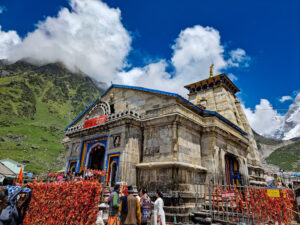
Kedarnath Temple In Uttrakhand
Kedarnath Temple is one of the most revered Hindu pilgrimage sites situated in the Rudraprayag district of the Indian state of Uttarakhand. It holds immense significance in Hindu mythology and is dedicated to Lord Shiva. The temple is located at an altitude of 3,583 meters (11,755 feet) above sea level, amidst the majestic Himalayan range.
The temple is part of the Char Dham Yatra, which includes three other pilgrimage sites: Badrinath, Gangotri, and Yamunotri. It is believed that visiting these four sites can help achieve spiritual enlightenment and wash away sins.
Kedarnath Temple is steeped in legends, with the most famous one being associated with the Pandavas from the Hindu epic Mahabharata. According to mythology, after the Kurukshetra War, the Pandavas sought forgiveness from Lord Shiva for killing their own kin. However, Lord Shiva was avoiding them and took the form of a bull to escape. Eventually, when the Pandavas found him, he dived into the ground leaving behind his hump, which is worshipped as the divine conical rock inside the temple.
The temple itself is built of massive stone slabs over a rectangular platform and is surrounded by snow-capped peaks and lush green valleys. Due to its high altitude, the temple remains open only for six months every year, from April to November, during the Hindu pilgrimage season.
Kedarnath Temple attracts millions of devotees and tourists every year, seeking blessings and spiritual solace in the serene and pristine surroundings of the Himalayas. It is not only a place of religious significance but also a testament to the rich cultural heritage of India Kedarnath Temple In Uttrakhand.
Kedarnath Temple is a revered Hindu temple located in the Garhwal Himalayan range near the Mandakini River in the state of Uttarakhand, India. It is one of the twelve Jyotirlingas, which are considered to be the holiest shrines of Lord Shiva. The temple is situated at an altitude of 3,583 meters (11,755 feet) above sea level, making it one of the highest among the Jyotirlingas.

Kedarnath Temple In Uttrakhand The temple has a rich history dating back thousands of years, although the current structure is believed to have been built in the 8th century by Adi Shankaracharya, a revered Hindu saint and philosopher. Kedarnath Temple is constructed in the traditional North Indian architectural style, with a stone edifice and a conical dome.
Kedarnath Temple In Uttrakhand Every year, the temple attracts thousands of pilgrims and devotees, especially during the summer months when it is accessible. The pilgrimage to Kedarnath is a part of the Char Dham Yatra, which also includes visits to Badrinath, Gangotri, and Yamunotri.
Kedarnath Temple In Uttrakhand In 2013, the temple suffered significant damage due to devastating floods and landslides in the region. However, extensive restoration efforts have been undertaken since then, and the temple has been largely rebuilt and restored to its former glory.
Access to the temple is limited to certain months of the year due to heavy snowfall and harsh weather conditions in the region during the winter. Pilgrims typically visit the temple from late April to early November when the weather is more favorable. The journey to Kedarnath involves a trek of several kilometers from Gaurikund, the nearest road point, or can be accessed via helicopter services from nearby towns like Phata and Sersi.
Kedarnath Temple, located in the state of Uttarakhand, India, is one of the most sacred Hindu temples dedicated to Lord Shiva. It holds immense significance in Hindu mythology and pilgrimage traditions. Here are some key points about Kedarnath Temple In Uttrakhand:
- Location: Situated in the Garhwal Himalayan range near the Mandakini River, Kedarnath Temple is nestled amidst breathtaking natural beauty at an altitude of 3,583 meters (11,755 feet) above sea level.
- Historical Significance: The temple’s origins are ancient, believed to date back to the Mahabharata era. Legend has it that the Pandavas, after the Kurukshetra War, sought forgiveness from Lord Shiva for their sins related to the war. Lord Shiva eluded them repeatedly and finally took refuge at Kedarnath in the form of a bull. The Pandavas followed him there and found his hump reappearing in various places. At Kedarnath, the hump is said to have resurfaced as a triangular-shaped shrine, which is worshipped as Kedarnath Temple.
- Jyotirlinga: Kedarnath is one of the twelve Jyotirlingas, sacred representations of Lord Shiva, each of which is considered to be self-manifested. The Jyotirlinga at Kedarnath is believed to be one of the most powerful and sacred manifestations of Lord Shiva.
- Architectural Style: The temple architecture follows the traditional North Indian style, characterized by its stone edifice and conical dome. It stands as a testament to ancient Indian architectural brilliance and craftsmanship.
- Accessibility: Due to its high altitude and mountainous terrain, reaching Kedarnath Temple can be challenging. Pilgrims typically undertake a trek of several kilometers from Gaurikund, the nearest road point, to reach the temple. Helicopter services are also available from nearby towns like Phata and Sersi for those who prefer aerial transportation.
- Pilgrimage Season: The temple remains open to devotees only for a certain period each year, typically from late April to early November. During the winter months, the region is covered in heavy snow, making it inaccessible Kedarnath Temple In Uttrakhand.
- 2013 Tragedy: In June 2013, Kedarnath and its surrounding areas were severely affected by flash floods and landslides, resulting in massive devastation and loss of lives. The temple complex also suffered significant damage. However, extensive restoration efforts have been undertaken since then to rebuild and restore the temple and its surroundings Kedarnath Temple In Uttrakhand.
Kedarnath Temple continues to attract millions of devotees and pilgrims from across the country and around the world, who undertake the arduous journey to seek the blessings of Lord Shiva and experience the spiritual aura of this sacred site.
One thought on “Kedarnath Temple In Uttrakhand”